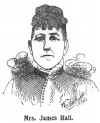county, Kansas in the fall of 1871; and from there to Norton November of the same year.
He raised a field of corn on sod in 1872, which was the first corn marketed in this county.
When he arrived in Cloud county in the fall of '71 he had sixty dollars in money.
He spent all of this for provisions and hiring teams to bring them to
Norton. Shortly after arriving here Mrs. Hall's mother sent them $150.00.
They then returned to Cloud county and bought a breaking plow, one Texas ox and one bull.
The bull had never had a yoke on. Early in the Spring of 1872 with this team, Jim began breaking the prairie.
Mrs. Hall would lead the bull and Jim would hold the plow.
 When they started from Cloud county Jim gave $5.00 for two pigs and Mrs. Hall traded her hat for six hens and a rooster.
These were the first pigs and chickens ever brought into the county. Their household furniture consisted of a table and some stools which Jim made from a cottonwood puncheon; he made a bedstead of some forks and poles and stretched a buffalo hide over it.
When they started from Cloud county Jim gave $5.00 for two pigs and Mrs. Hall traded her hat for six hens and a rooster.
These were the first pigs and chickens ever brought into the county. Their household furniture consisted of a table and some stools which Jim made from a cottonwood puncheon; he made a bedstead of some forks and poles and stretched a buffalo hide over it.
In May of '72 Jim bought three more Texas steers and a larger plow of Coleman, paying for them in breaking.
During the summer he broke seventy-five acres at $4 00 per acre. Mrs. Hall drove the cattle during the entire season, Jim held the plow and did the swearing.
In June he traded the bull to Ed Newell for a cow and traded the small breaking plow to Abe Louk for another cow.
In the fall after the breaking season was over he traded his two yoke of Texas steers for a span of horses and traded the two cows for a wagon.
From this time on he felt rich as he could now ride in his own conveyance.
He went to Cloud county where he spent the winter, returning early in the spring of '73.
That year he raised a good crop of corn and wheat. The wheat averaged forty bushels to the acre.
In the fall of '73 he sold everything he had except his team, proved up on his land and went back to Kane county, Illinois, and stayed there five years, farming and teaming.
In the fall of 1878 he returned to his old stamping
|